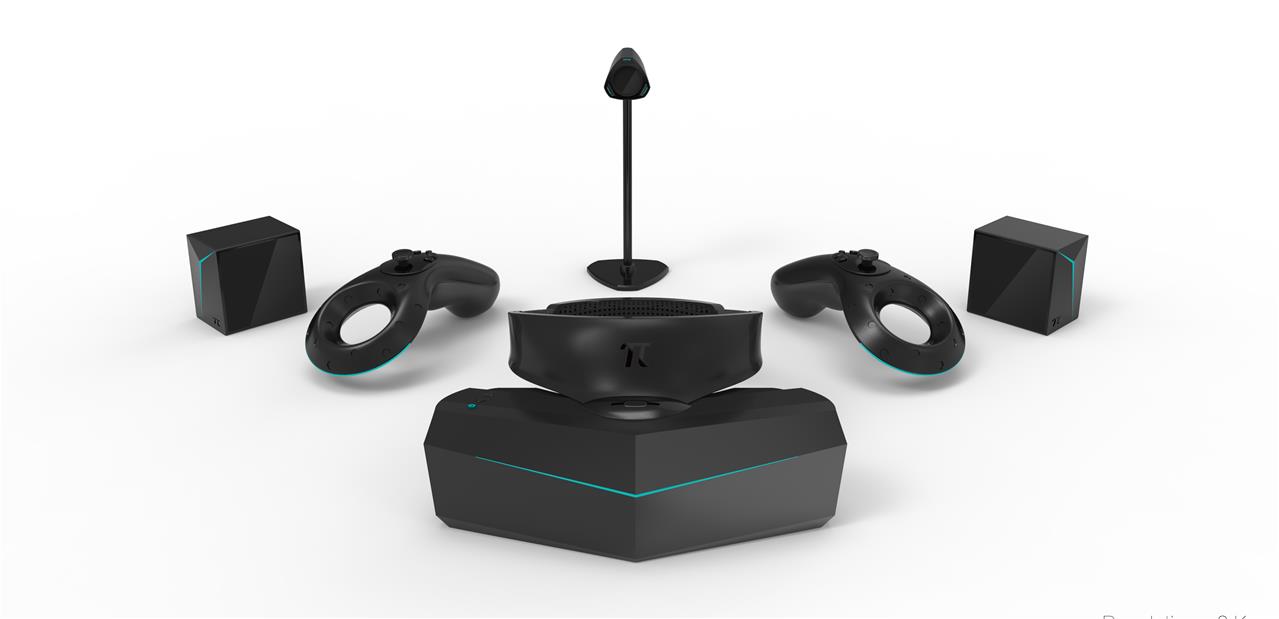
To the deep disappointment of many, the VR industry is experiencing an alarming lull. The appearance of the first generation of consumer helmets was not accompanied by the appearance of impressive content, or by the transfer of existing AAA video games (Skyrim and Fallout 4 are not considered), and VR arcade games remain rare today.
Of course, the process of adapting a new technology takes time. Even the iPhone did not immediately conquered the whole world. According to Andrey Ivashentsev, Game Insight Director for Innovations, now VR technologies are at the stage of attracting first followers.
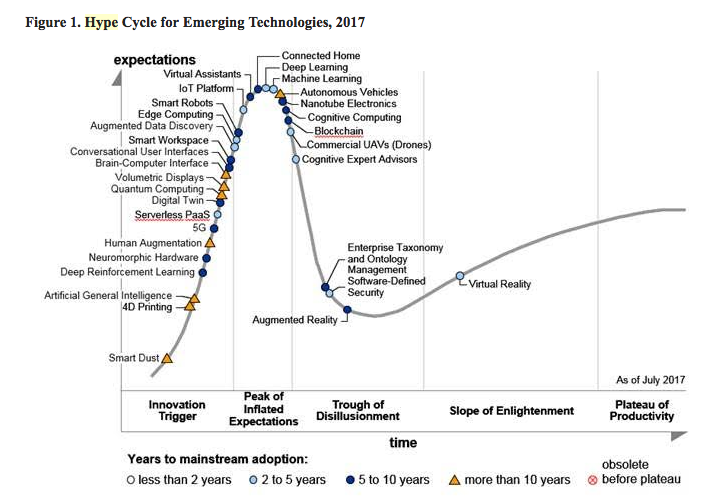 Gartner, new technology maturity cycle, 2017
Gartner, new technology maturity cycle, 2017Others are not so optimistic. Take the consulting company Gartner, which very accurately describes the situation with its concept of the maturity cycle. Now VR helmets are in the stage of reaching the "plateau of productivity", and until the adoption of the technology by the masses, at best, it remains from 2 to 5 years.
In fact, the development cycle of VR helmets is repeated. Even Palmer Lucky did not invent anything new, but took old ideas and re-implemented them. Virtual reality will really “fly up” only if the experience of the past is taken into account, and the mistakes are corrected. It's time to get acquainted with this past.
Homo habilis virtual glasses: 19th century stereoscope
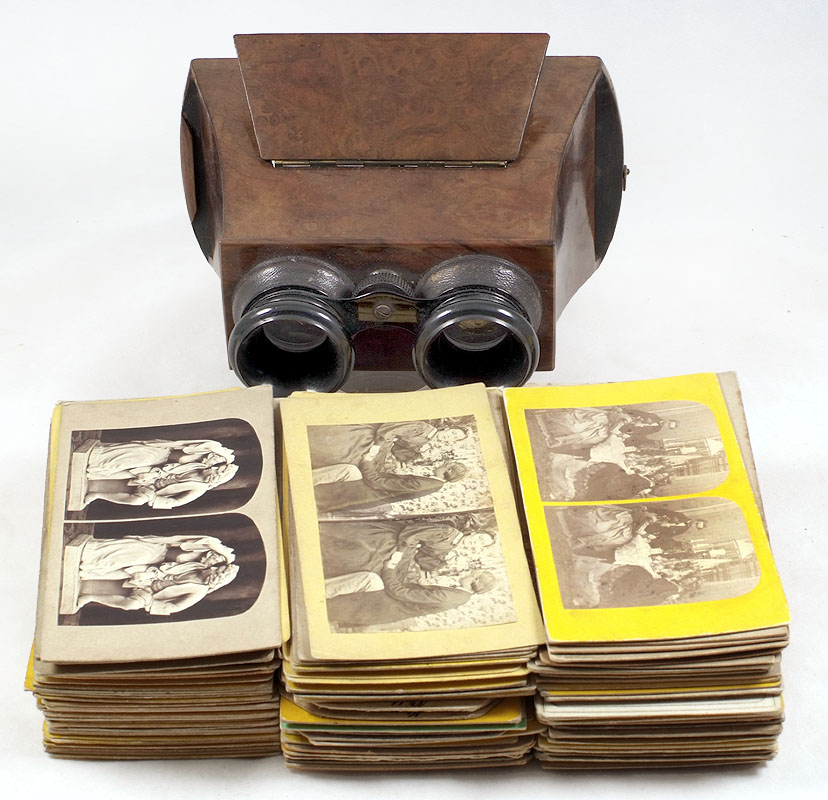 What is it:
What is it:The stereoscope, the very first “virtual reality headset,” was created by the English physicist and inventor Sir Charles Wheatstone in 1838. A strange device demonstrated the importance of human binocular vision: two mirrors placed at an angle reflected two pictures so that the observer saw a three-dimensional object. Then the Scottish physicist Sir David Brewster improved the concept, getting rid of the mirrors and replacing them with lenses. For its operation, a stereoscope required a slide from a stereo pair - two images made at a short distance from each other for the effect of volume.
A photograph suitable for creating such images was just invented at that time. Brewster went to Paris, where he met with the pioneer of photography, Jules Dubosque, who first began to make stereo-daggerotypes and stereoscopes. The new "gadget" was presented to the public at the World Exhibition in 1851, after which it gained incredible popularity (more than 1 million stereoscopes were sold in England in 1953).
What ended:
Inexpensive and easy to use, the stereoscope was a technological breakthrough for its time. All the necessary technologies for it appeared on time, and there were no competing devices, so consumers had nothing to compare with. Simple stereoscopes still exist, but, most importantly, the basic principle of their work is the basis of all glasses and virtual reality helmets. They even look like people to their upright ancestors.
Stereoscope 2.0: View-Master
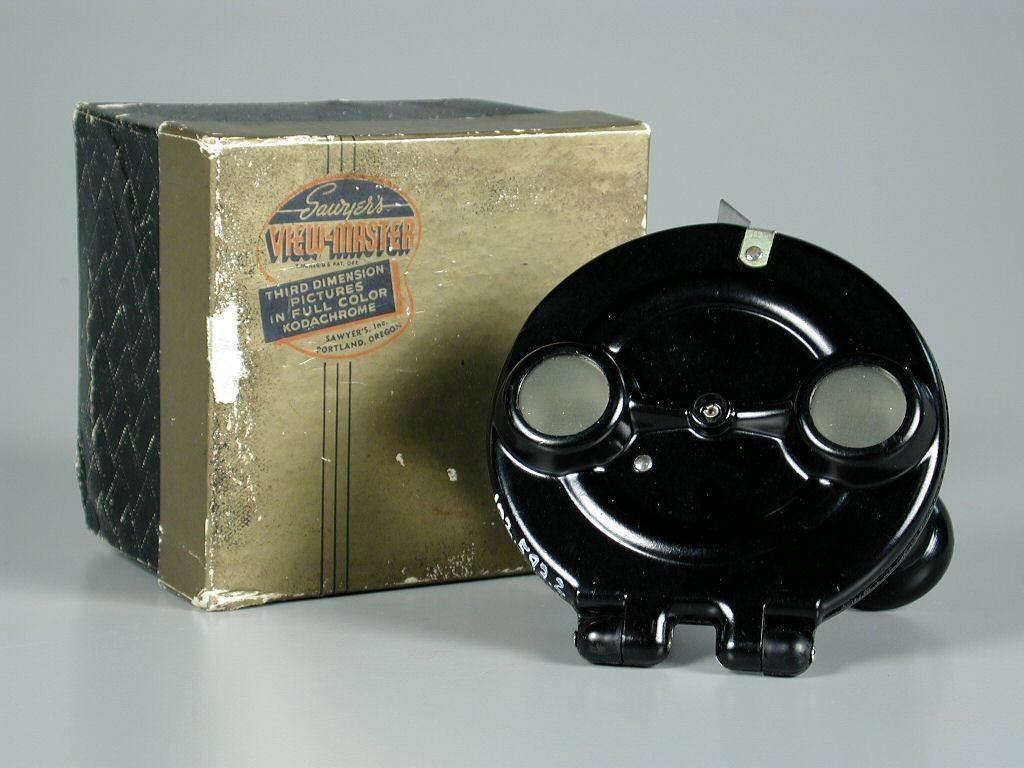 What is it:
What is it:In 1935, the American company Eastman Kodak launched the production of Kodachrome color film. Just four years later, Sawyer's small Oregon photo services service developed a View-Master color stereoscope, which for a long time became one of the most beloved and recognizable gadgets in the United States.

The stereoscope worked with special cardboard discs in which 14 color slides were mounted, that is, seven stereo pairs. Since Sawyer's produced postcards with scenic views and sights, the same images were on disks. During World War II, the American government ordered the company millions of special discs for the View-Master, which would train servicemen to identify enemy ships and aircraft at a distance of a shot. The campaign was the most successful advertising that Sawyer's could have dreamed of, so that the device’s fame only dimmed in the 70s. After that, the View-Master transformed into a typical toy. Gadgets under this brand are still being produced, but we are no longer talking about stereoscopes, but VR headsets for smartphones.

In the 1950s, the Soviet View-Master, the Stereoscope-1, produced in Leningrad at the photo accessories plant, appeared in the USSR. He, like the subsequent improved models of Stereoscope-2 and Stereoscope-3, worked with square-shaped cards. A more common model was the Salyut stereoscope and its Salyut-M modification.
What ended:A successful military order provided the gadget with wide recognition in the United States. A lot of content was produced for the View-Master. After the slides with beautiful views and the outlines of enemy transport, Sawyer's began producing discs with footage from TV shows and movies. Particularly successful was the deal with Disney, because children liked the color images of cartoon characters and photos of Disneyland. No less decisive role played by the immutability of the format and size of the media. View-Master models have changed, and the old discs did not fit.
The first real VR gadgets: Sensorama and Telesphere Mask
 What is it:
What is it:Back in 1935, science fiction writer Stanley Weinbaum described a virtual reality helmet in his story “Pygmalion Glasses”. A year later, the writer died of lung cancer and did not have time to see how the fruit of his imagination became extremely accurate in reality. This was done by an American filmmaker and inventor Morton Hellig, who in 1962 built and patented the virtual machine Sensorama. She blew the viewer with air, sprayed perfume, showed the record "from the first person" on two separate screens, and the sound changed depending on how his virtual source moved.
Sensorama subsequently became the most famous invention of Hellig, but in 1960 he patented video glasses, which did roughly the same thing. The Telesphere Mask gadget was equipped with miniature picture tubes for image transmission, an audio system, and some device for transmitting smell and wind effects.

Heliga's virtual reality required special films, and the inventor made five demo films on his own. Four of them were devoted to riding a motorcycle, go-map, bicycle and helicopter flight. In the fifth, invented for potential Hollywood investors, the viewer was entertained with a belly dance performed by a New York dancer.
What ended:Production of VR-machines was very expensive, not cheap and costing shooting suitable material for them. In addition, the technique was fragile and demanded careful handling. One trial Sensorama device was installed on the territory of Universal Studios, and the commercial success of the early virtual reality ended there. Hollywood bosses had no idea how to sell this new type of entertainment. The pioneer of virtual reality came too early into a world that was not ready either technologically or morally.
The prototype of the futuristic Telesphere Mask helmet is still kept by the widow of the inventor, Marianna Helig.
Sword of Damocles Sutherland
 What is it:
What is it:Yes, in the 60s and 70s, the Western public was completely unprepared for an alternate reality (except for the one that Hunter Thompson described so vividly). Therefore, many developments exclusively appeared and remained within the walls of institutions. The helmet of the virtual / augmented reality "Damocles sword" of the famous scientist Ivan Sutherland was not an exception to the rule.
The terrible installation was only partially a helmet. A significant part of it was too cumbersome for a man’s head, and hung from the ceiling, and this earned her nickname. The system included a computer that generated a simple wireframe model.
Despite the lack of graphics, the device was able to track the position of the eyes and the user's head. The Sword of Damocles was built in 1968 by Sutherland and his student Bob Sproul as a research project. They hardly saw any use of the dangerous colossus in real life, so that it remained an interesting scientific artifact of the era.

Sutherland, among other things, is to thank for the object-oriented approach to programming, developments in the field of graphic displays and computer graphics. The professor had his own vision of what we call today virtual reality: “The limit of the development of the display will be a room in which a computer can control the existence of matter. A chair in such a room would fit perfectly for sitting on it. Handcuffs created in such a room will be held down, and a bullet created in such a room will be fatal. ” Maybe it’s not bad that he didn’t bring the Damocles Sword to the end.
NASA VIEW VR helmet
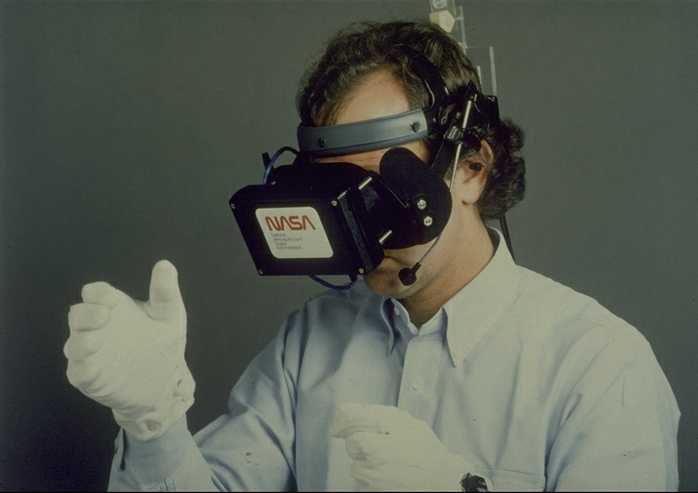 What is it:
What is it:In addition to scientists from the Massachusetts Institute of Technology, the military and, of course, NASA were also engaged in displays for virtual or augmented reality. In 1985, the space agency demonstrated VR-VIEW helmet and DataGlove, touch gloves for it.
The system was connected to a separate computer, after which a generated three-dimensional color image was transferred to the helmet, significantly exceeding Sutherland's earlier workings. The helmet was equipped with liquid crystal displays with a viewing angle of 120 degrees in all directions, and tracked the movements of the user's head. The input device was either a "three-dimensional cursor" or gloves.
What ended:The development of NASA looked very impressive, almost like the helmets of the Daft Punk group. Despite this, she remained a prototype. According to Stefan Ellis, head of the spatial perception laboratory at Ames Research Center, the technology of the 80s was not “mature enough”. Early VR systems were distinguished by too heavy helmets, too slow computers, constant failures of sensory gloves, and users suffered from headaches and motion sickness. As a result, work in this area was resumed only 20 years later.
Lawnmower Helmet: Eyephone
 What is it:
What is it:With the development of a virtual reality system, NASA was assisted by VPL Research, whose founder, Jaron Lanier, coined the term “virtual reality”.
Lanier worked at Atari, but after its collapse into two parts in 1984, he lost his position. A gifted programmer and musician focused on his own projects, one of which turned into a full-fledged company. Over the years, VPL has released a DataGlove touch glove, a DataSuit touch suit, an AudioSphere surround sound system, the Isaac virtual reality engine and a programming language for it, and, most importantly, EyePhone virtual reality glasses.
Total released three versions of EyePhone. The first was a LEEP lens, a 90 degree viewing angle of 60 degrees, the resolution of the liquid crystal display was 184.7 x 138.6 pixels per eye. Beginning with the second version, Fresnel lenses were used, the viewing angle increased to 100 degrees with a small one, and the resolution eventually increased to 416x277 pixels. The first version weighed 2.4 kilograms, the second - 1.1 kilograms.
What ended:
The first two Eyephone models cost $ 9,000, the third - already $ 49,000. Despite the very high price, they were really sold to the mass consumer. In 1992, Eyephone became one of the “stars” of the cult film “The Lawn Mower”, forever entrenched in the mass consciousness as the correct image of virtual reality glasses. In 1999, the VPL filed for bankruptcy and sold all of its patents to Sun Microsystems. However, spitting into eternity was done.
Robocop Helmet: Sega VR
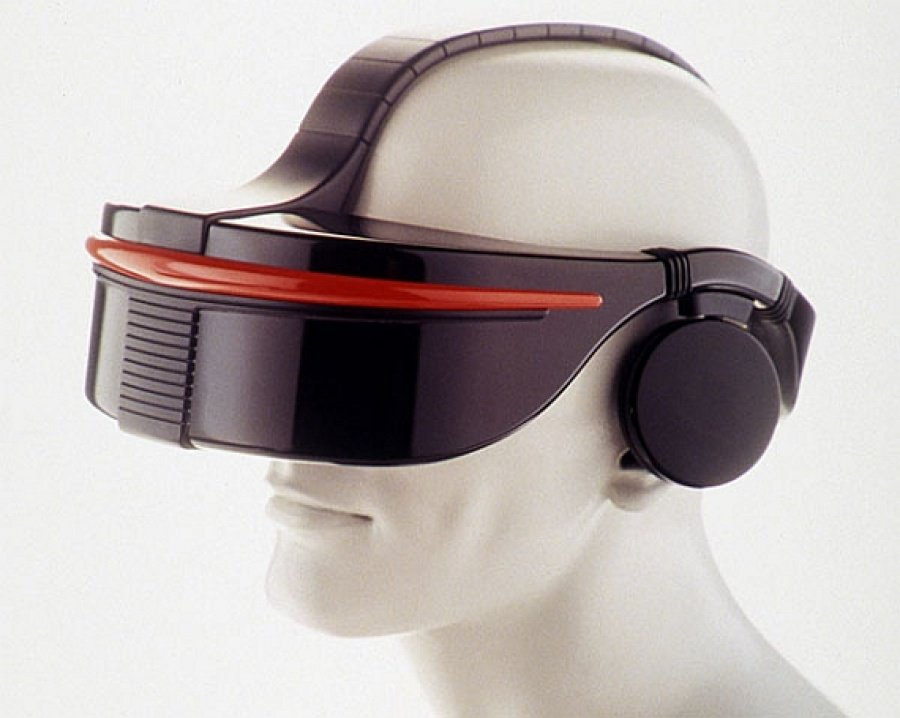 What is it:
What is it:In 1991, the Japanese company Sega joined the virtual arms race and announced the development of a Sega VR helmet for the Sega Genesis and Saturn consoles. A promising project foreshadowed a completely new technological era for bored gamers and cost only $ 200. The helmet itself combines two separate LCDs with a resolution of 300 x 200 dots, built-in headphones for surround sound, and a well-designed head tracking system. The sensors updated the position of the helmet 100 times per second, and the picture on the displays changed accordingly.
The most remarkable feature of the ambitious device from the 90s was its design, which was largely inspired by the 1951 film “The Day the Earth Stopped”, the legendary Star Trek series and, of course, Paul Verhoeven's Robocop. For the helmet released four games, including one, called "Matrix Snatcher" - six years before the release of "The Matrix".
What ended: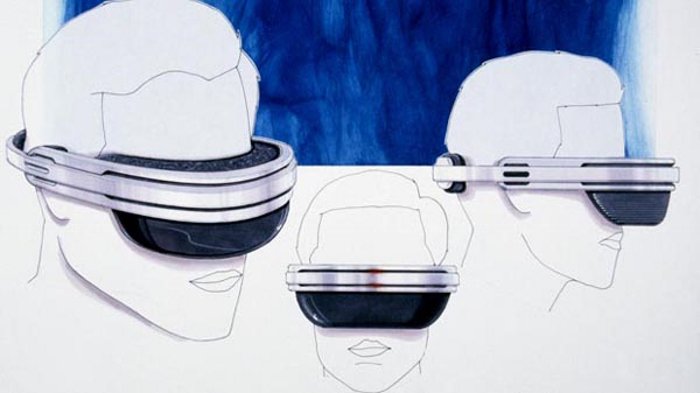
The prototype was presented at the international electronics exhibition CES-1993, the presentation was held behind closed doors. Those who were able to try out the novelty were not particularly impressed, so the ominous silence and oblivion followed the loud launch. Sega representatives said they abandoned the project for the safety of players, especially children. According to rumors, 40% of testers simply could not use a helmet due to rocking. As a result, VR helmets were sent to Japanese arcades.
Red and Black Sunset Era: Nintendo Virtual Boy
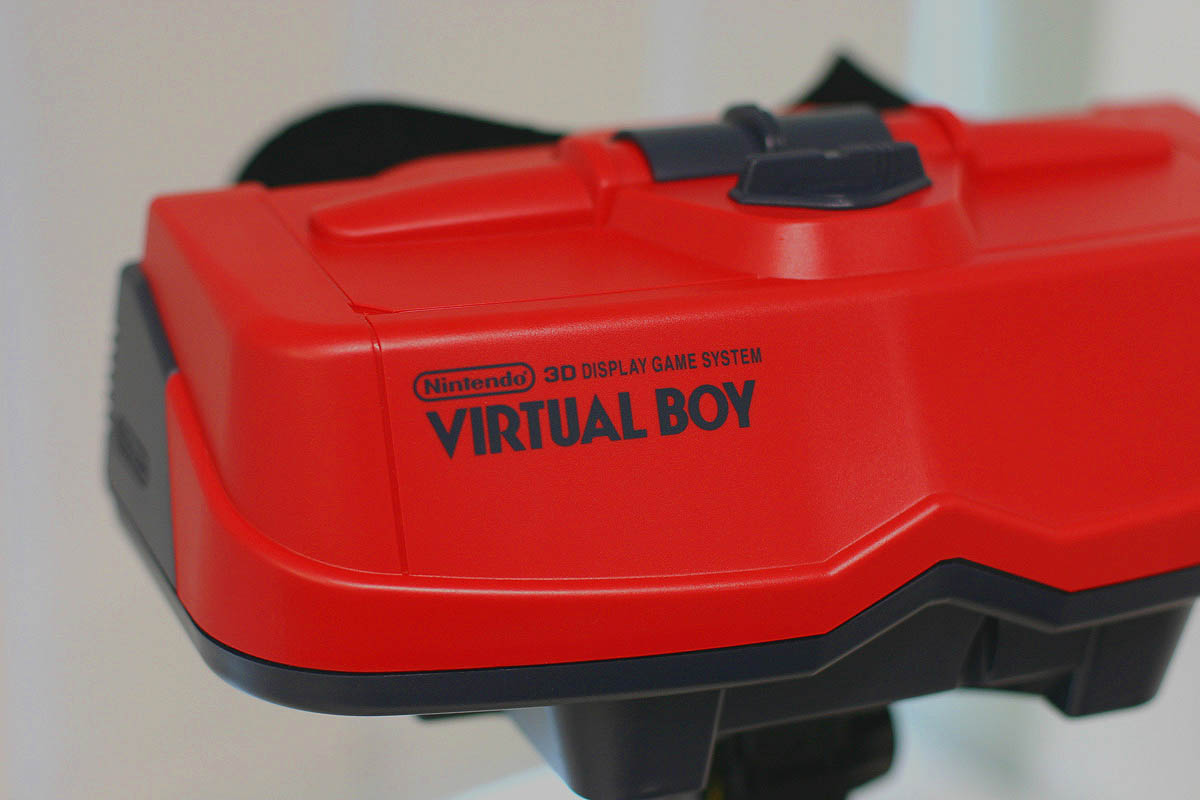 What is it:
What is it:The Japanese gaming giant Nintendo, do not get past such a daring call from Sega, as a virtual reality helmet. The answer was the prefix-helmet Nintendo Virtual Boy - perhaps the strangest VR-device since the “Damocles Sword”.
The basis was the development of the Massachusetts-based company Reflection Technologies, the Private Eye headset, and the monochrome display invented by them. Instead of a full-fledged matrix, it consisted of a line of 1x224 LEDs and oscillating mirrors that formed an image with a mechanical scan of 50.2 Hz. The cheapest red LEDs were chosen for the display, the final resolution was 384 x 224 pixels per eye. The device was also equipped with a built-in speaker, and it worked either from the mains or from 6 finger-type batteries.
The main system developer, Gumpei Yokoi, originally planned to create a lightweight headset that attaches to the head. Alas, his vision failed to translate into reality. Nintendo lawyers were afraid that the company would sue if a child in such a helmet had an accident on the road and the device fragments stuck in his eyes. Because of the precautions taken, the helmet became overweight, as a result it was placed on the legs. The height of the legs was not tuned, which did not add convenience to the system. I had to forget about tracking, about portability and about aesthetics.

At the same time, the corporation was preparing to release a Nintendo 64 console, on which games legendary game designer Shigeru Miyamoto worked tirelessly. He couldn’t do VR-console either, so the developers from Intelligent Systems were in charge of the games for Virtual Boy. In addition, deadlines were tight, so less experienced programmers had to try to do something. This became something of the game "Space Pinball", revenge simulator boxer Teleroboxer, and Mario Tennis.
What ended:The system caused great interest when it was officially presented in November 1994. The audience lost interest in Virtual Boy right away, testing the first devices at Shinoshikai (Nintendo Space World) in the same month and at CES in January 1995. In Japan, sales of the console started in June 1995, in the USA - in August, it cost $ 179.95. In the American press, the device was reservedly called the evolution of the View-Master, without expressing much enthusiasm. Total managed to sell about 770,000 devices, which was the biggest failure for Nintendo. VirtualBoy fiasco for a long time cooled the interest of gaming companies in virtual reality.
VR for MS-DOS: Forte VFX1
 What is it:
What is it:Of course, experiments with VR glasses did not end with a loud virtual boy failure. Sony, Siemens and many small companies continued to create their own projects throughout the second half of the 90s and in the first decade of the new century. All such developments remained either prototypes or niche entertainment - like the VFX1 helmet of the New York company Forte.
A distinctive feature of this device was thoughtfulness, which Nintendo did not have enough for the departed brainchild. Despite the solid weight of 1.1 kilograms, the helmet was well balanced and did not seem heavy. Both lenses and the distance between them were adjusted to the person’s eyes, the pillows and the lining provided a comfortable fit, and the AKG stereo headphones - high-quality surround sound. The “visor” of the helmet was raised up so that it was not necessary to remove the entire unit, which is very convenient. To control the game provided Cyberpuck, a joystick in the form of a puck.

The VFX1 was designed to work with a PC, and a special ISA VIP card was even bundled with it, which was inserted into the computer before directly connecting the device. Included were supplied drivers and compatible games. Yes, this helmet worked with such hits of the 90s as Doom, Quake, Heretic and Descent, not to mention the excellent compatibility with flight simulators.

The resolution of the LCDs themselves was 263x230 pixels, slightly less than the standard 320x240. The tiny viewing angle left much to be desired: 35.5 degrees horizontally and 26.4 degrees vertically. But the device perfectly recorded the turns of the head along three axes thanks to the built-in gyroscope and the sensor of the earth’s magnetic field. Playing in Doom, it was quite possible to imagine yourself as a sort of spacemarine in a close helmet that fell into the Martian hell.
What ended: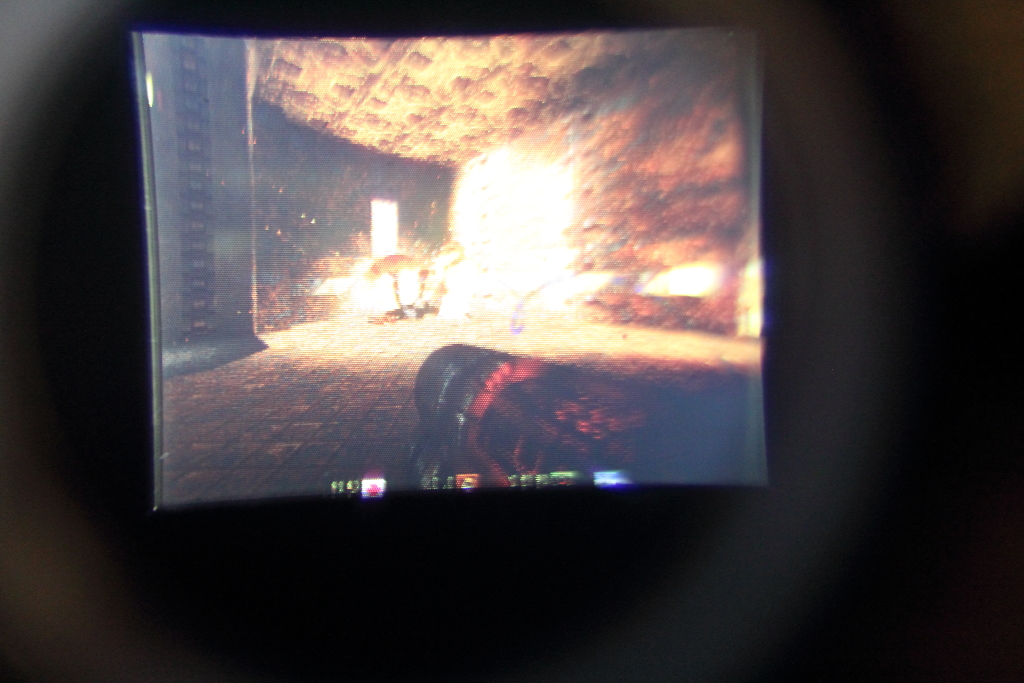
The initial cost of the helmet VFX1 was about a thousand dollars. The huge amount was the first obstacle, and the second - the need to deal with the settings, hardware and drivers. With all the prevalence of DOS, not every user of those times was able to deal with the command line. Alas, this real miracle of technology turned out to be too complicated and expensive for an ordinary gamer.
Budding Oculus Rift
 What is it:
What is it:Another spiral in the history of VR-helmets began to spin in 2012, when an unknown startup Oculus VR launched a campaign on Kickstarter to finance a new VR-helmet called Rift. Insanely successful campaign raised $ 2.5 million.

The company's founder, 20-year-old Palmer Lucky, has been interested in technology since childhood and experimented with it. He collected various HMD devices and dreamed of a helmet in which, let's say, one could play the VR version of the Chrono Trigger.
As a result, he went so far as to make such a helmet on his own. Oculus Rift has truly become a dream come true: the newest OLED displays, 1080 x 1020 pixels per eye, a sweep frequency of 90 Hz, a viewing angle of 110 degrees, built-in headphones with 3D sound. The most important thing is the Constellation camera system, which helps to track the position of the user's head and the Oculus Touch controllers (in the helmet itself there was an accelerometer and a gyroscope, the basis of the system). The development took four years of life Lucky: the release of Oculus Rift was held in March 2016.
What ended:In March 2014, Facebook acquired a successful startup for $ 2 billion. Immediately after this, ZeniMax Media sued Oculus VR for allegedly stealing technology. The jury ruled that the young innovator violated the non-disclosure agreement and fined Oculus $ 500 million in favor of ZeniMax. In 2016, Lucky’s reputation suffered once again, due to the support of the presidential campaign of Donald Trump, who eventually won the US election. In 2017, he left Facebook and his brainchild with him.
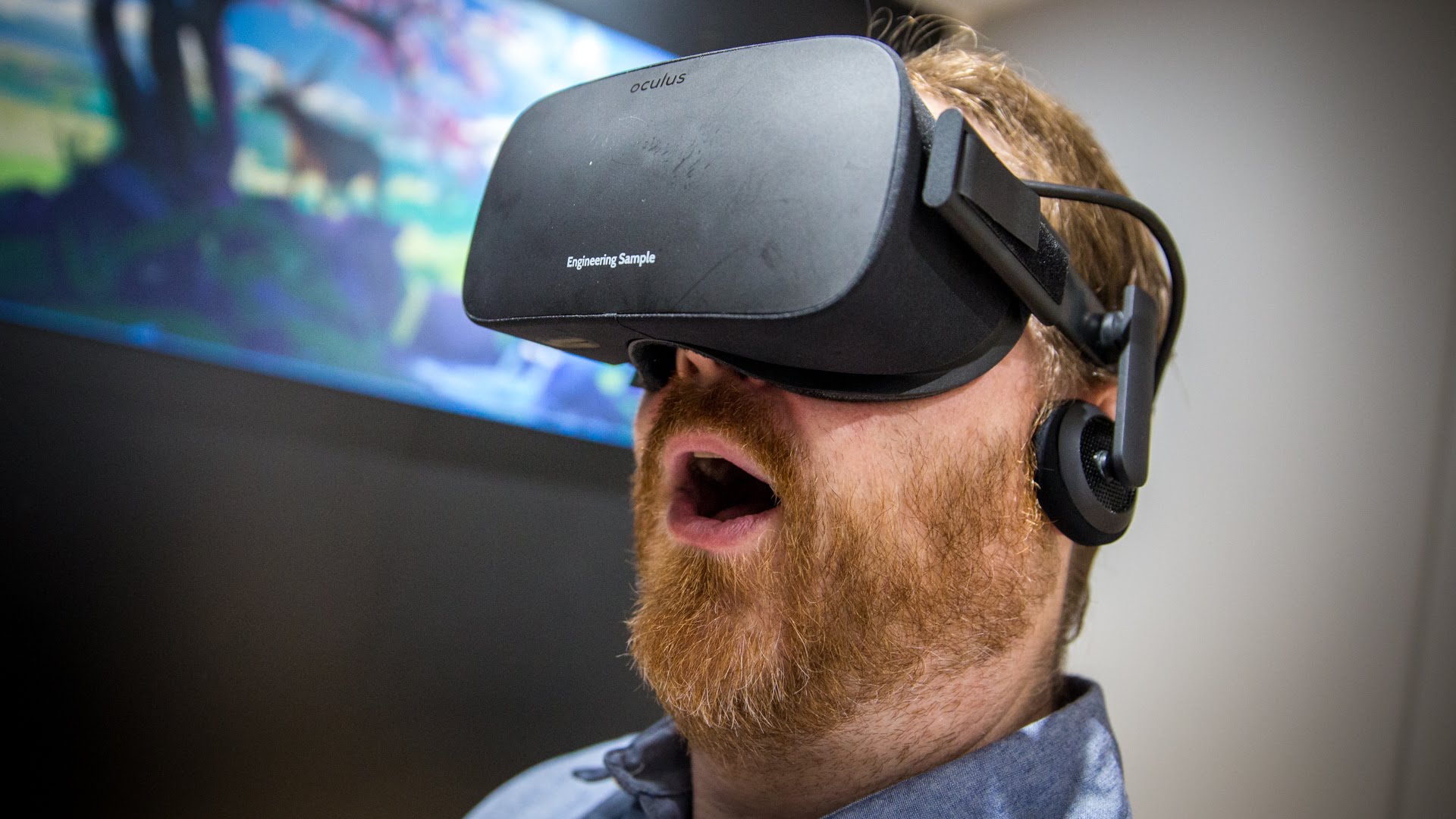
These events have somewhat negatively affected the public perception of the Oculus product. However, really serious problems were created by two factors: a) the need to purchase a powerful computer with a new video card for a rather expensive helmet b) a limited choice of entertainment content. Attracted to the creation of the last developers faced with difficulties in adapting existing genres and limitations of the helmet to the new format. With the video, things are a little better, but few are willing to spend a thousand dollars for equipment for watching movies and pornography in 3D.
Google cardboard and friends
 What is it:
What is it:Google has become the next major stop on the road to VR progress. In 2014, while Rift was still in the project hell, incomprehensible cartons were distributed to visitors to the Google I / O conference.
It turned out that the masks with angular-looking masks with a separate smartphone slot are formed from them. Wearing this on the face and pulling the magnet, the person was instantly transferred to virtual reality according to Google.
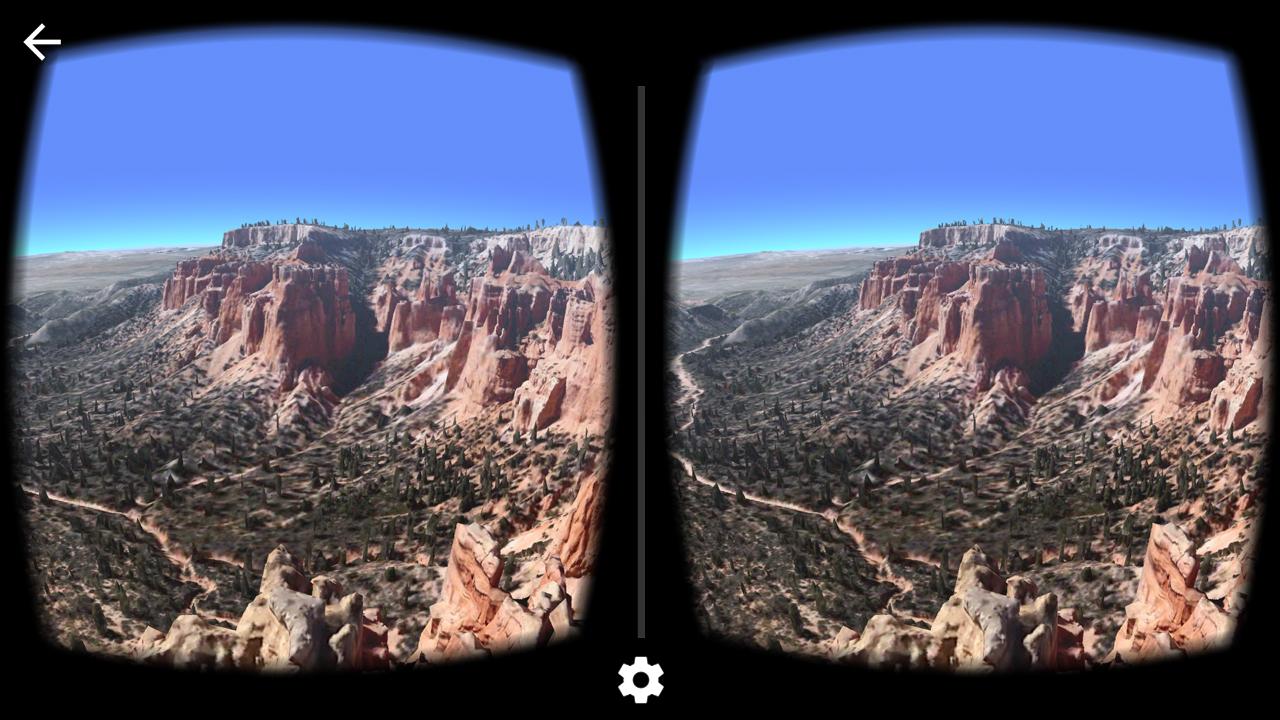
Cardboard at that time seemed the most logical step that could be taken. Smartphone displays are getting better day by day, just like the power of small processors. Even the gyro was in place. Mobile gaming is gaining momentum. All that remains is to add a pair of lenses and an application.

The example of Google was followed by many. Samsung, Xiaomi,
Mattel , and dozens of small startups hoping to ride a rising wave presented their VR headsets for smartphones.
What ended:Most smartphones are not designed to bring them to the nose and in addition to increase the screen with a healthy lens. Because in this case the illusion of a beautiful color display is broken in a very rough way: the thinnest lines between the pixels become visible.

The so-called mosquito net effect is perhaps not the most serious defect for the long-suffering VR-technology. Smartphones "do not pull" serious games, as they are optimized for other purposes (but the change of generations and the emergence of devices like the iPhone X can correct the situation). By the way, Rift also has a mesh, but in the case of more sophisticated hardware there are ways to improve image quality. However, this is happening against the background of devices where the borders between the pixels are not visible.
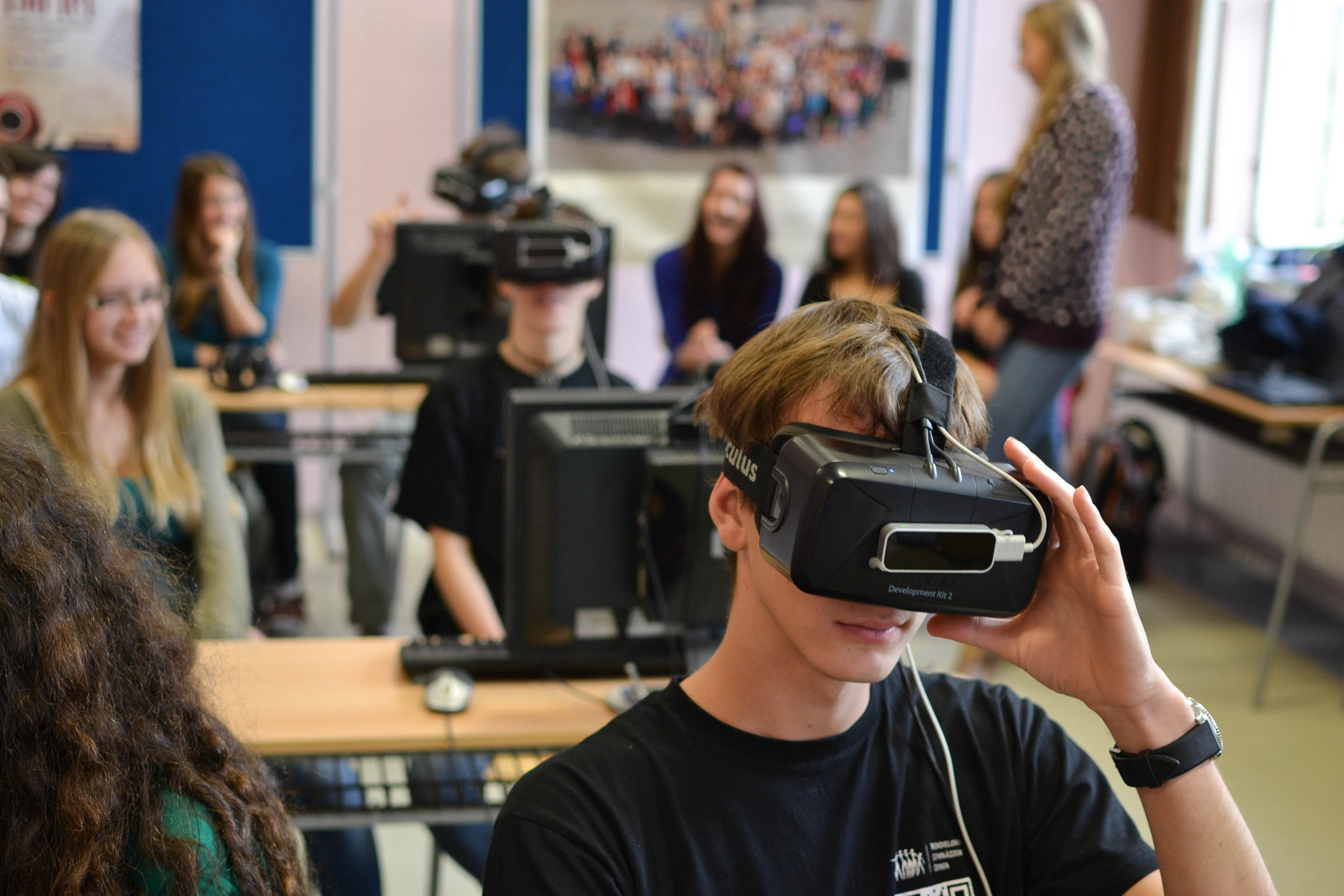
As an educational tool, the headset has no equal. But now there is so much entertainment that it’s hard to compete with a VR accessory. Even the initial enthusiasm is often replaced by indifference, because of which the device is sent to gather dust on the shelf.
Free HTC Vive
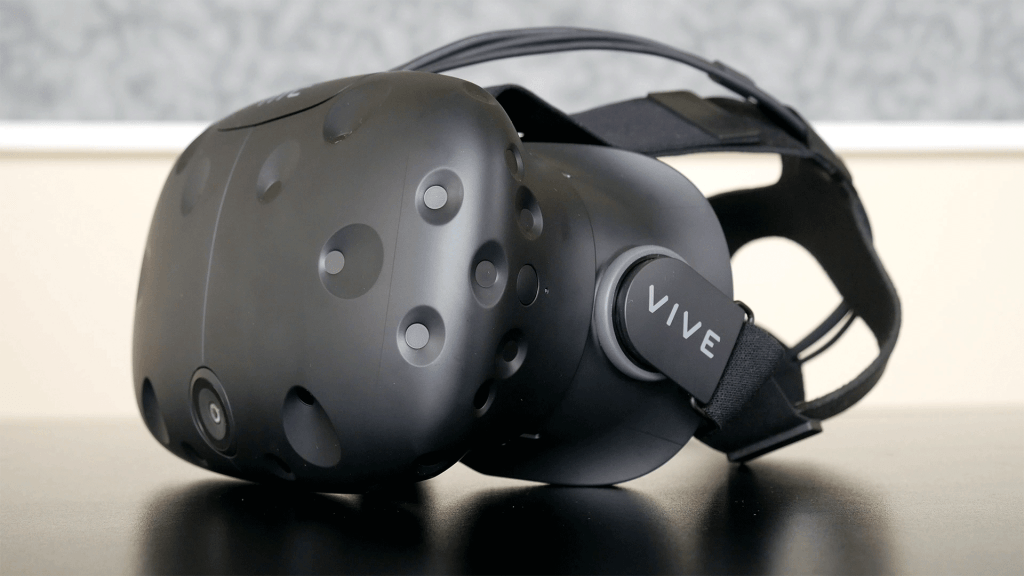 What is it:
What is it:American Valve Corporation, creator of the Half-Life games, Dota 2 and the Steam platform, joined the new VR era in 2015. Then it became known that the company announced that, together with the Taiwanese HTC Corporation, it was working on the virtual reality glasses
HTC Vive for PC.

The development is largely repeated Oculus Rift. The final resolution, scanning frequency, viewing angle are the same. The display is most likely made at the same Samsung plant, and the computer requirements even exceeded Oculus' immodest claims.
The difference was in such an important detail as tracking. Instead of optical sensors, it was equipped with the Lighthouse system, consisting of "laser towers" with infrared LEDs. The principle is similar, the light serves as a guide for the helmet and controllers. As a result, the user can not only spin in place, but also take several steps in a 3.5 x 3.5 meter space. For a home VR device, this distinction was revolutionary, because earlier technology did not allow anything like that.
What ended:After the successful launch of the consumer version of the HTC Vive in April 2016, good news began to appear less and less. According to some reports, the development of Valve was selling much better than Oculus glasses, but in August 2017, HTC began to think about how to get rid of its VR division. In any case, trying to win the hearts of consumers, both competitors have reduced the prices of their headsets and continue to develop new models of helmets. Games worthy of a powerful "filling" Vive, still does not exist.
Hidden Dragon: PlayStation VR
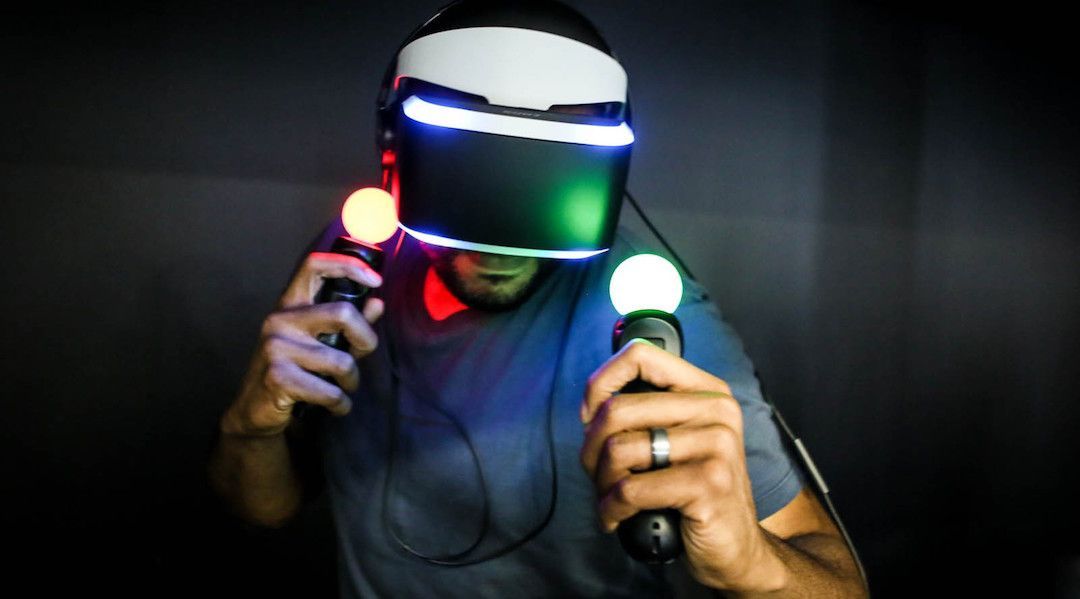 What is it:
What is it:Sony has been engaged in virtual reality since at least the 90s, and even sold Glasstron glasses at one time. In 2014, the company announced the Morpheus VR-helmet project, its response to the challenges of the new millennium.
In 2015, it became known that the helmet will be called the Playstation VR. In October of the following year, the gadget was launched at a price of $ 399 in the US and € 399 in Europe.
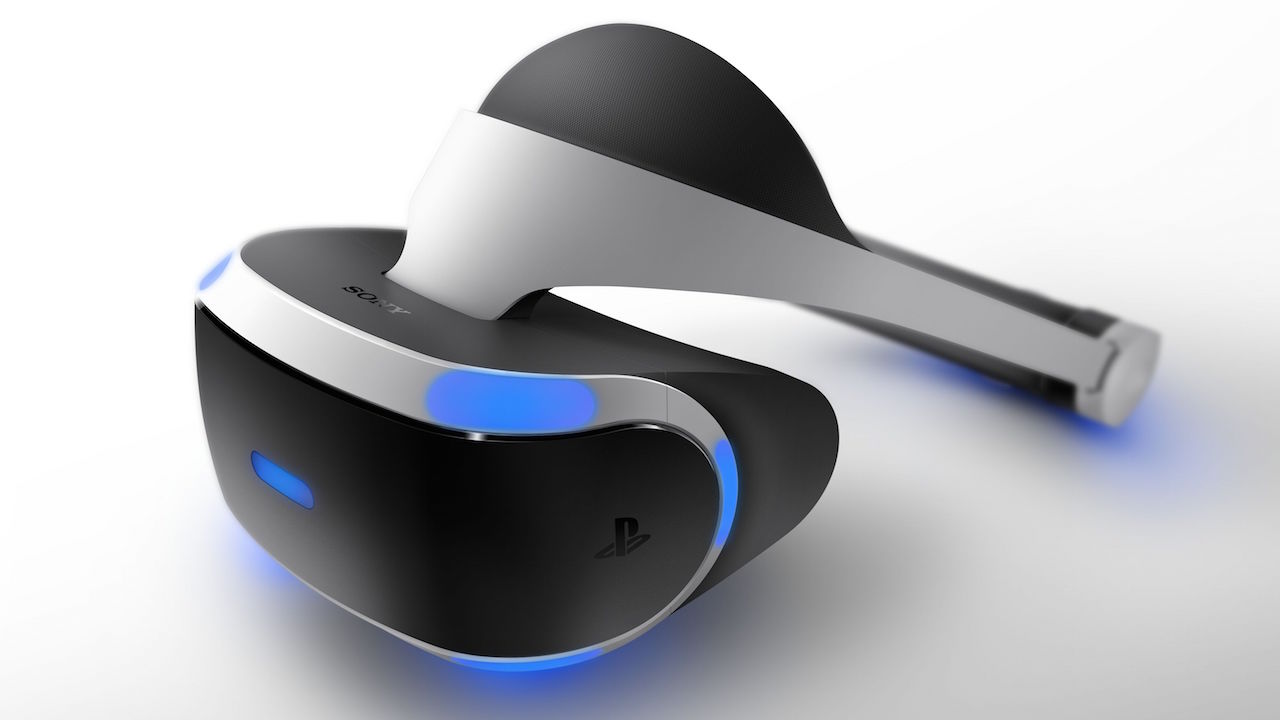
According to the characteristics, the glasses were somewhat inferior to their competitors from Valve and Oculus. The resolution of OLED displays is 960 x 1080 pixels per eye, the viewing angle is 100 degrees, but the refresh rate is higher - 120 Hz. The most important advantage in the eyes of consumers was the absence of the need to buy an expensive computer that replaced the Playstation 4 console. The camera released for the PlayStation in 2013 is responsible for tracking.
What ended:Of all three "main" VR-helmets of the new millennium, it was the Playstation VR that achieved the greatest success. Sony sold more than 1 million devices, favored by price, ease and ease of installation, and a large library of games. The presence of a large number of PlayStation users also did not hurt.
Next generation of virtual reality: Pimax 8K
 What is it:
What is it:Let's return to Kickstarter, where the “virtual wave” of the 21st century started from. Since Oculus, VR headsets for smartphones have appeared on the platform more than once. However, in the second half of September, the Chinese startup
Pimax launched a campaign of a full-fledged helmet with an ultra-high resolution of 8K (3840 x 2160 in one eye).
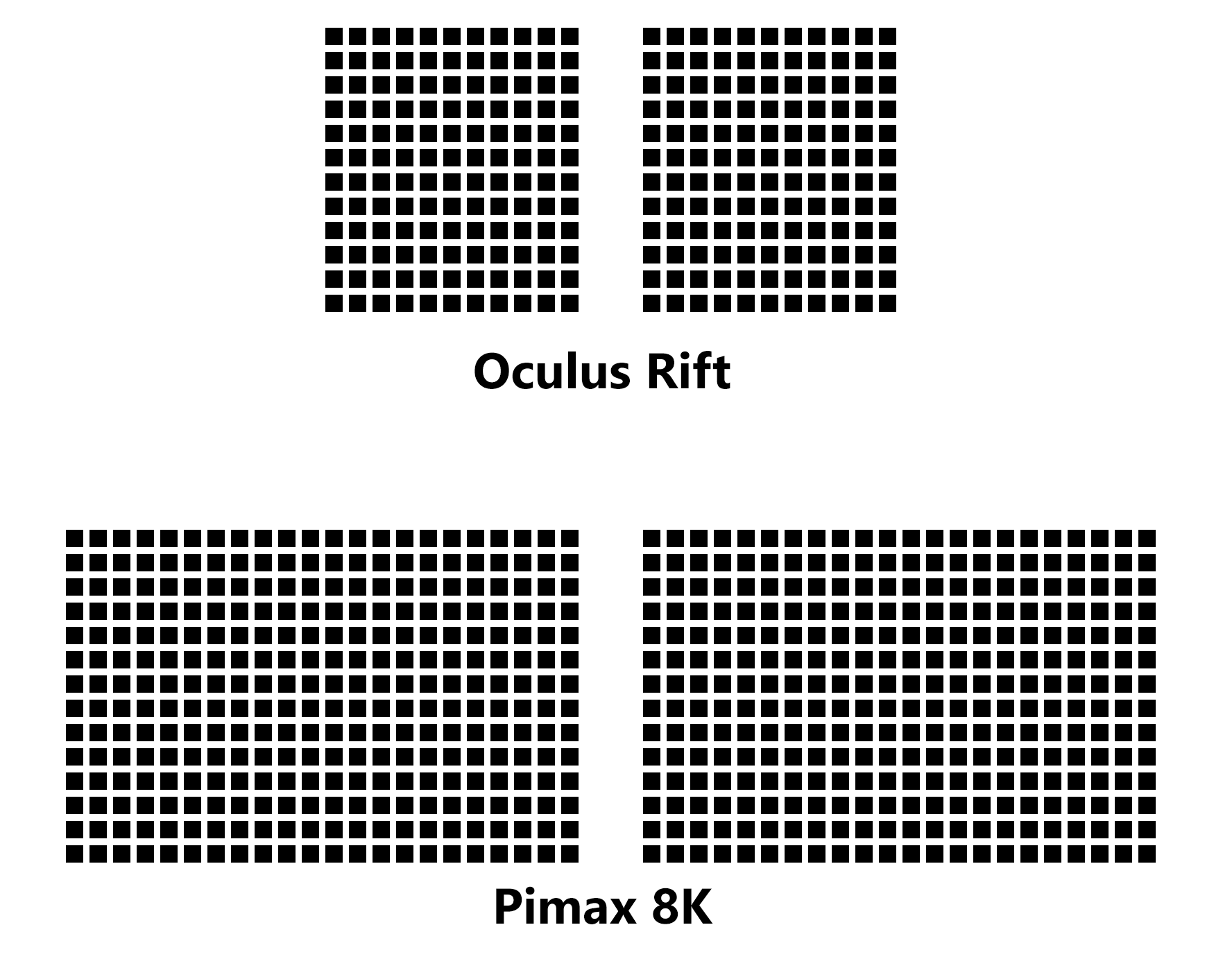
Such a huge number of pixels fit on the screen due to the fact that engineers from the Middle Kingdom changed their orientation. Vive, Oculus and Playstation VR displays are almost square. At Pimax - stretched horizontally, due to which an impressive panoramic view of all 200 degrees is obtained, and the “mosquito net” disappears almost completely.
It is noteworthy that instead of OLED in Pimax, liquid crystal displays are used, which, according to the creators of the helmet, are made according to technology adapted for VR.For tracking, the Pimax uses the Lighthouse technology, the same as in Vive, so you can walk around the room and in the virtual space at the same time with such a helmet on your head.What is over: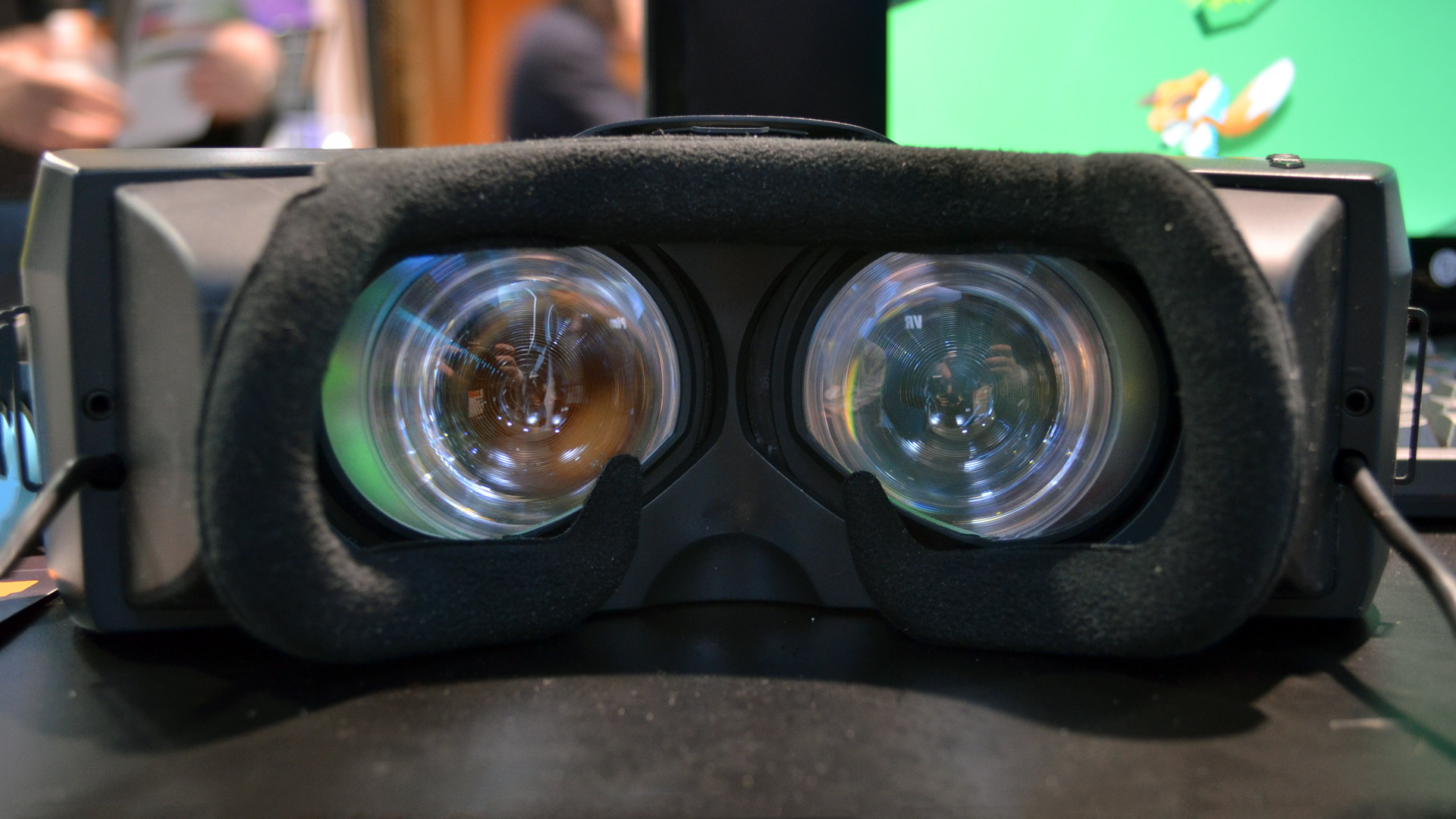 It is too early to say whether the Pimax 8K will find a place for itself in the history of virtual reality gadgets. Since the device is just preparing to go out, only a small number of outsiders managed to try it out, including at the IFA 2017 electronics exhibition held in September. We ourselves are waiting for our test sample to look at it closer and then share our impressions.The Pimax crowdfunding campaign managed to beat the Oculus Rift record and raise $ 3.2 million. For the Chinese campaign, which does not hide its roots, this is a very worthy result. Before the end of the fees, there are still three days left, so that everyone has the opportunity to order the first virtual reality helmet with a giant resolution on the Kickstarter campaign page and get it one of the first.And what do you think about the endless struggle of the VR industry for a place in the sun? Did we miss the important retro-VR glasses for history? Share your opinion in the comments.
It is too early to say whether the Pimax 8K will find a place for itself in the history of virtual reality gadgets. Since the device is just preparing to go out, only a small number of outsiders managed to try it out, including at the IFA 2017 electronics exhibition held in September. We ourselves are waiting for our test sample to look at it closer and then share our impressions.The Pimax crowdfunding campaign managed to beat the Oculus Rift record and raise $ 3.2 million. For the Chinese campaign, which does not hide its roots, this is a very worthy result. Before the end of the fees, there are still three days left, so that everyone has the opportunity to order the first virtual reality helmet with a giant resolution on the Kickstarter campaign page and get it one of the first.And what do you think about the endless struggle of the VR industry for a place in the sun? Did we miss the important retro-VR glasses for history? Share your opinion in the comments.